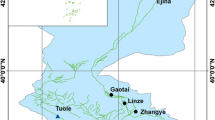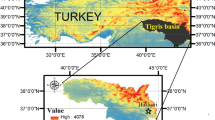Abstract
Evapotranspiration (ET) is one of the main components of the hydrological cycle. It is a complex process driven mainly by weather parameters, and as such, is characterized by high non-linearity and non-stationarity. This paper introduces a methodology combining wavelet multiresolution analysis with a machine learning algorithm, the multivariate relevance vector machine (MVRVM), in order to predict 16 days of future daily reference evapotranspiration (ETo). This methodology lays the ground for forecasting the spatial distribution of ET using Landsat satellite imagery, hence the choice of 16 days, which corresponds with the Landsat overpass cycle. An accurate prediction of daily ETo is needed to improve the management of irrigation schedules as well as the operations of water supply facilities like canals and reservoirs. In this paper, various wavelet decompositions were performed and combined with MVRVM to develop hybrid models to predict ETo over a 16-days period. These models were compared to a MVRVM model, and models accuracy and robustness were evaluated. The addition of 10 days of forecasted air temperature as additional inputs to the forecasting models was also investigated. The results of the wavelet-MVRVM hybrid modeling methodology showed that a reliable forecast of ETo up to 16 days ahead is possible.







Similar content being viewed by others
References
Ahmad S, Popoola A, Ahmad K (2005) Wavelet-based multiresolution forecasting. UniS Technical Report, June 2005
Allen RG, Pereira LS, Raes D, Smith M (1998) Crop evapotranspiration: guidelines for computing crop water requirements. FAO Irrigation and Drainage Paper No. 56, FAO, Rome, 300
Allen RG, Pruitt WO, Wright JL, Howell TA, Ventura F, Snyder R, Itenfisu D, Stedudo P, Berengena J, Yrisarry JB, Smith M, Raes D, Perrier A, Alves I, Walter I, Elliot R (2006) A recommendation on standardized surface resistance for hourly calculation of reference ETo by the FAO 56 Penman-Monteith method. Agric Water Manag 81:1–22
ASCE Task Committee on Definition of Criteria for Evaluation of Watershed Models of the Watershed Management, Irrigation, Drainage Division (ASCE) (1993) Criteria for evaluation of watershed models. J Irr Drain Eng 119(3):429–442
Cannas B, Fanni A, See L, Sias G (2006) Data preprocessing for river flow forecasting using neural networks: wavelet transforms and data partitioning. Phy Chem Earth 31(18):1164–1171
CEMP- Community Environmental Monitoring Program website, http://www.cemp.dri.edu. Accessed Dec 2012
Chou CM, Wang RY (2002) On-line estimation of unit hydrographs using the wavelet- based LMS algorithm. Hydrol Sci J 47(5):721–738
Cigizoglu HK (2003) Incorporation of ARMA models into flow forecasting by artificial neural networks. Environmetrics 14(4):417–427
Cobaner M (2013) Reference evapotranspiration based on Class A pan evaporation via wavelet regression technique. Irrig Sci 31(2):119–134
Darshana, Pandey A, Pandey RP (2013) Analysing trends in reference evapotranspiration and weather variables in the Tons River Basin in Central India. Stoch Environ Res Risk Assess 27(6):1407–1421
Daubechies I (1992) Ten Lectures on Wavelets. SIAM, Philadelphia
Efron B, Tibshirani R (1998) An introduction of the bootstrap, monographs on statistics and applied probability, vol 57. CRC Press LLC, Boca Raton
El-Shafie A, Alsulami AM, Jahanbani H, Najah A (2013) Multi-lead ahead prediction model of reference evapotranspiration utilizing ANN with ensemble procedure. Stoch Environ Res Risk Assess 27:1423–1440. doi:10.1007/s00477-012-0678-6
Gao G, Chong-Yu X, Chen D, Singh VP (2012) Spatial and temporal characteristics of actual evapotranspiration over Haihe River basin in China. Stoch Environ Res Risk Assess 26:655–669
Gorantiwar SD, Meshram DT, Mittal HK (2011) Seasonal ARIMA model for generation and forecasting evapotranspiration of Solapur district of Maharashtra. J Agrometeorol 13(2):119–122
Hernandez S, Morales L, Sallis P (2011) Estimation of reference evapotranspiration using limited climatic data and Bayesian model averaging. In: 5th European symposium on computer modeling and simulation, 2011, pp 59–63
Kaheil YH, Rosero E, Gill MK, McKee M, Bastidas LA (2008) Downscaling and forecasting of evapotranspiration using a synthetic model of wavelets and support vector machines. IEEE Trans Geosci Remote Sens 46(9):2692–2707
Kisi O (2007) Evapotranspiration modelling from climatic data using a neural computing technique. Hydrol Process 21:1925–1934
Kisi O (2011) Evapotranspiration modeling using a wavelet regression model. Irrig Sci 29:241–252
Küçük M, Kahya E, Cengiz TM, Karaca M (2009) North Atlantic oscillation influences on Turkish lake levels. Hydrol Process 23(6):893–906
Labat D (2005) Recent advances in wavelet analyses: part 1. A review of concepts. J Hydrol 314(1–4):275–288
Labat D, Ronchail J, Guyot JL (2005) Recent advances in wavelet analyses: part 2-Amazon, Parana, Orinoco and Congo discharges time scale variability. J Hydrol 314(1–4):289–311
Landeras G, Ortiz-Barredo A, Lopez JJ (2009) Forecasting weekly evapotransiration with ARIMA and artificial neural network models. J Irrig Drain Eng ASCE 135(3):323–334
Lau KM, Weng H (1995) Climate signal detection using wavelet transform: how to make a time series sing. Bull Am Meteorolo Soc 76:2391–2402
Legates DR, McCabe GJ (1999) Evaluating the use of “goodness-of-fit” measures in hydrological and hydroclimatic model validation. Water Resour Res 35(1):233–241
Li X, Ding J, Li H (1999) Combing neural network models based on wavelet transform. J Hydraul 2:1–4
Mallat SG (1989) A theory for multi resolution signal decomposition: the wavelet representation. IEEE Trans Pattern Anal Mach Intell 11(7):674–693
Mariño MA, Tracy JC, Taghavi SA (1993) Forecasting of reference crop evapotranspiration. Agric Water Manag 24:163–187
Mishra AK, Özger M, Singh VP (2011) Wet and dry spell analysis of Global Climate Model-generated precipitation using power laws and wavelet transforms. Stoch Environ Res Risk Assess 25(4):517–535
Nash JE, Sutcliffe JV (1970) River flow forecasting through conceptual models. I. J Hydrol 10:282–290
Pandey PK, Pandey V, Singh R, Bhakar SR (2009) Stochastic modelling of actual Black Gram evapotranspiration. J Water Resour Prot 1:448–455
Park J, Choi M (2014) Estimation of evapotranspiration from ground-based meteorological data and global land data assimilation system (GLDAS). Stoch Environ Res Risk Assess. doi:10.1007/s00477-014-1004-2
Partal T (2009) Modelling evapotranspiration using discrete wavelet transform and neural networks. Hydrol Process 23(25):3545–3555
Partal T, Cigizoglu HK (2008) Estimation and forecasting of daily suspended sediment data using wavelet-neural networks. J Hydrol 358:317–331
Percival DB, Walden AT (2000) Wavelet methods for time series analysis. Cambridge University Press, Cambridge
Pulido-Calvo I, Gutiérrez-Estrada JC (2009) Improved irrigation water demand forecasting using a soft-computing hybrid model. Biosyst Eng 102:202–218
Thayananthan A, Navaratnam R, Stenger B, Torr PH, Cipolla R (2008) Pose estimation and tracking using multivariate regression. Pattern Recognit Lett 29(9):1302–1310
Ticlavilca AM, McKee M (2011) Multivariate bayesian regression approach to forecast releases from a system of multiple reservoirs. Water Resour Manag 25:523–543
Ticlavilca AM, McKee M, Walker WR (2013) Real-time forecasting of short-term irrigation canal demands using a robust multivariate Bayesian learning model. Irrig Sci 31(2):151–167
Tipping ME (2001) Sparse Bayesian learning and the relevance vector machine. J Mach Learn 1:211–244
Tipping ME (2004) Bayesian inference: an introduction to principles and practice in machine learning. In: Bousquet O, von Luxburg U, Ratsch G (eds) Advanced lectures on machine learning. Springer, Berlin, pp 41–62
Tipping ME, Faul AC (2003) Fast marginal likelihood maximization for sparse Bayesian models. In Proceedings of the ninth international workshop on artificial intelligence and statistics, vol 1(3)
Torrence C, Compo GP (1998) A practical guide to wavelet analysis. Bull Am Meteorol Soc 79:61–78
Torres AF, Walker WR, McKee M (2011) Forecasting daily potential evapotranspiration using machine learning and limited climatic data. Agric Water Manag 98(4):553–562
Trajkovic S (1998) Comparison of prediction models of reference crop evapotranspiration. Facta Universitatis Ser Archit Civil Eng 1(5):617–626
Wang WG, Luo YF (2007) Wavelet network model for reference crop evapotranspiration forecasting. In: Wavelet analysis and pattern recognition (ICWAPR ‘07), vol 2, pp 751–755
Acknowledgments
Computational, storage and other resources from the Division of Research Computing in the Office of Research (DoRC) and Graduate Studies at Utah State University (USU) are gratefully acknowledged. The authors would like to thank Mr. John Hanks, director of the DoRC at USU, for his help in answering questions concerning cluster computing. The authors would also like to acknowledge the Center of Teaching, Research and Learning at the American University (Washington, DC) for providing access to their High-Performance Computing System (NSF grant BCS-1039497). This research could not have been done without the invaluable support of the Utah Water Research Laboratory (UWRL), and access to the weather data through the Community Environmental Monitoring Program monitored by the Desert Research Institute (DRI) of the Nevada System of Higher Education.
Author information
Authors and Affiliations
Corresponding author
Rights and permissions
About this article
Cite this article
Bachour, R., Maslova, I., Ticlavilca, A.M. et al. Wavelet-multivariate relevance vector machine hybrid model for forecasting daily evapotranspiration. Stoch Environ Res Risk Assess 30, 103–117 (2016). https://doi.org/10.1007/s00477-015-1039-z
Published:
Issue Date:
DOI: https://doi.org/10.1007/s00477-015-1039-z




